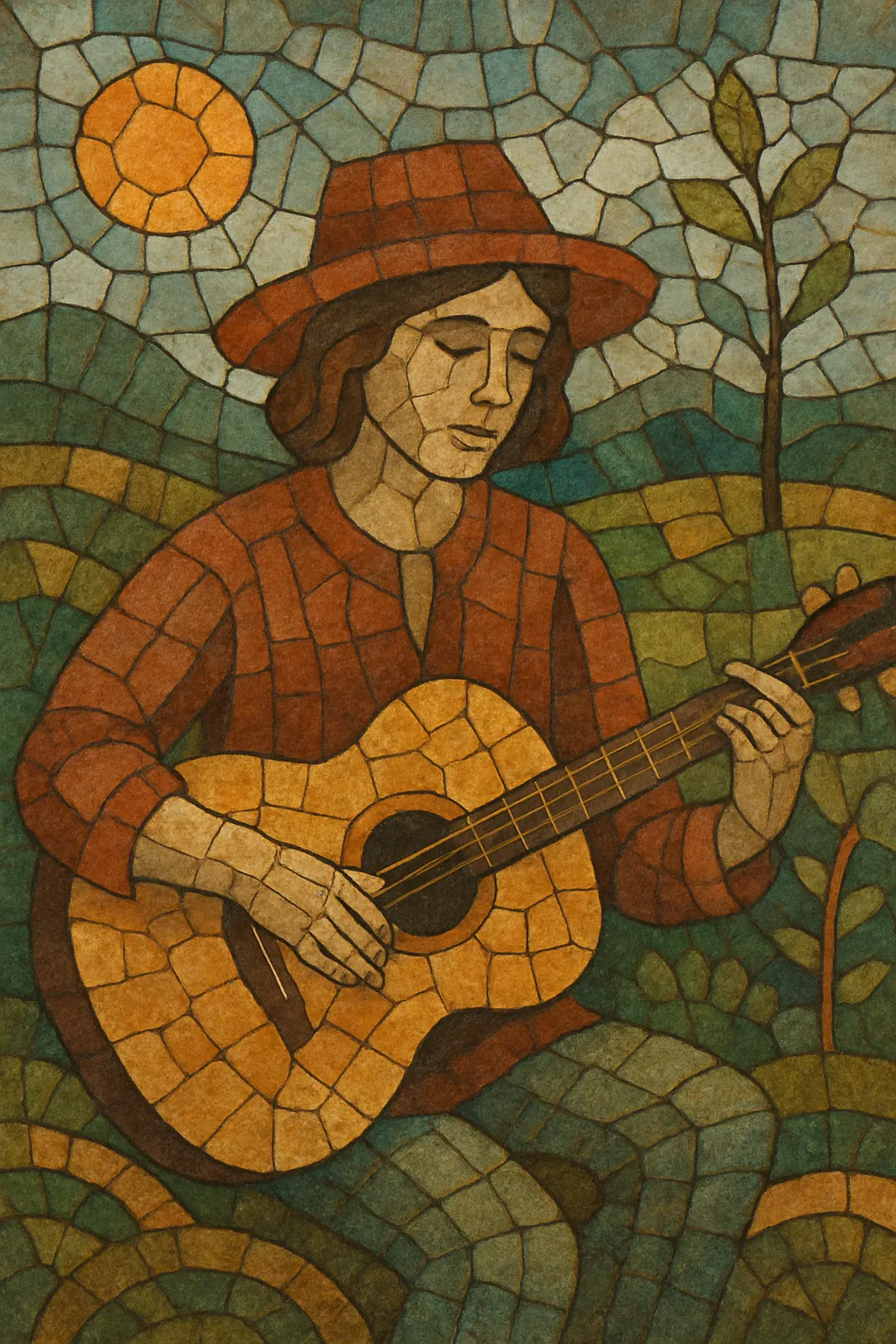
Indie folk blends the DIY ethos and sonic aesthetics of independent rock with the acoustic instrumentation, intimate storytelling, and melodic simplicity of traditional folk.
Timbres are typically warm and organic—fingerpicked acoustic guitars, close-mic’d vocals, subtle percussion, and spare ornamentation from banjo, mandolin, harmonium, or strings. Production often favors natural room ambiance, tape hiss, and gentle compression over glossy polish, creating a sense of proximity and emotional candor.
Lyrically, the style is reflective and poetic, focusing on personal narratives, place, nature, spirituality, and memory. Harmony tends to be diatonic and modal, with drones, open tunings, and layered vocal harmonies adding depth. While understated, arrangements can scale into lush, choir-like textures and chamber-folk swells, balancing fragility with grandeur.
Indie folk coalesced in the early-to-mid 2000s United States as independent musicians absorbed folk revival traditions through the lens of indie rock’s DIY culture. Precedents included the confessional singer‑songwriter tradition and lo‑fi home recording scenes, as well as anti‑folk and freak‑folk experiments that loosened folk’s formal boundaries.
Labels and communities such as Saddle Creek (Bright Eyes), Asthmatic Kitty (Sufjan Stevens), Sub Pop (Iron & Wine, Fleet Foxes), and Jagjaguwar/Dead Oceans (Bon Iver, The Tallest Man on Earth) amplified a wave of artists who favored intimate production, literate lyrics, and acoustic-centered arrangements.
Critics and blogs accelerated discovery, while a parallel folk‑pop boom (e.g., Mumford & Sons, The Lumineers) expanded acoustic sounds into the mainstream. Indie folk retained subtler aesthetics: choral harmonies, chamber strings, and pastoral imagery, heard in seminal records like Fleet Foxes’ "Fleet Foxes" (2008) and Bon Iver’s "For Emma, Forever Ago" (2007).
Throughout the 2010s, the palette broadened. Some artists fused chamber music and baroque pop; others integrated electronics and sound design (e.g., Bon Iver’s "22, A Million"), blurring lines with indietronica and ambient folk. Festivals (Newport Folk among others) and boutique studios nurtured the scene as international voices (Laura Marling, The Tallest Man on Earth, José González) contributed regional nuances.
Streaming playlists and home‑recording tools further democratized the sound, informing bedroom pop and lo‑fi indie while sustaining a global indie folk network. The genre remains a conduit for intimate storytelling—now as likely to feature modular synth pads and granular textures as banjo and brushed drums—without losing its core: closeness, clarity of voice, and songcraft.
Start with fingerpicked or strummed acoustic guitar; add banjo, mandolin, piano, harmonium, and light percussion (brushes, shakers, handclaps). A small string section (violin, cello) or woodwinds can provide chamber‑folk color. Keep tones warm and natural.
Use diatonic progressions (I–IV–V, I–vi–IV–V, ii–IV–I) with modal inflections (Dorian, Mixolydian). Explore open tunings (DADGAD, Open D, Open C) and capos for ringing drones and alternate chord shapes. Layer subtle vocal harmonies or small choirs to create lift without overwhelming the intimacy.
Favor mid‑tempo 4/4 or lilting 6/8/12‑8 feels. Let percussion be supportive rather than dominant—brush snare patterns, soft kick pulses, tambourine on choruses. Occasional compound meters or rubato intros keep arrangements organic.
Prioritize clear, singable melodies. Close‑mic lead vocals; consider gentle double‑tracking and blended harmonies. Falsetto passages and call‑and‑response choir layers add emotional scale while maintaining softness.
Write lyrically vivid, image‑rich lines about memory, place, nature, grief, faith, and everyday intimacies. Use concrete details and metaphor; balance personal confession with universal resonance. Allow space and silence to carry meaning.
Begin sparse (voice + guitar), then bloom with strings, horns, or vocal stacks. Use pedal notes and drones for continuity. Create dynamic arcs—quiet verses, textural builds, and restrained climaxes—avoiding overproduction.
Embrace natural rooms, tape hiss, and gentle saturation. Minimal editing preserves performance feel. Complement acoustic cores with tasteful electronics—pads, granular textures, or subtle samplers—to modernize without crowding the song.
Stick to compact forms (V–C–V–C–Bridge–C) or folk narratives with refrains. Demo at home, iterate lyrics and voicings, then overdub ensemble parts. Reference records by Bon Iver, Fleet Foxes, and Laura Marling for balance between intimacy and scope.

